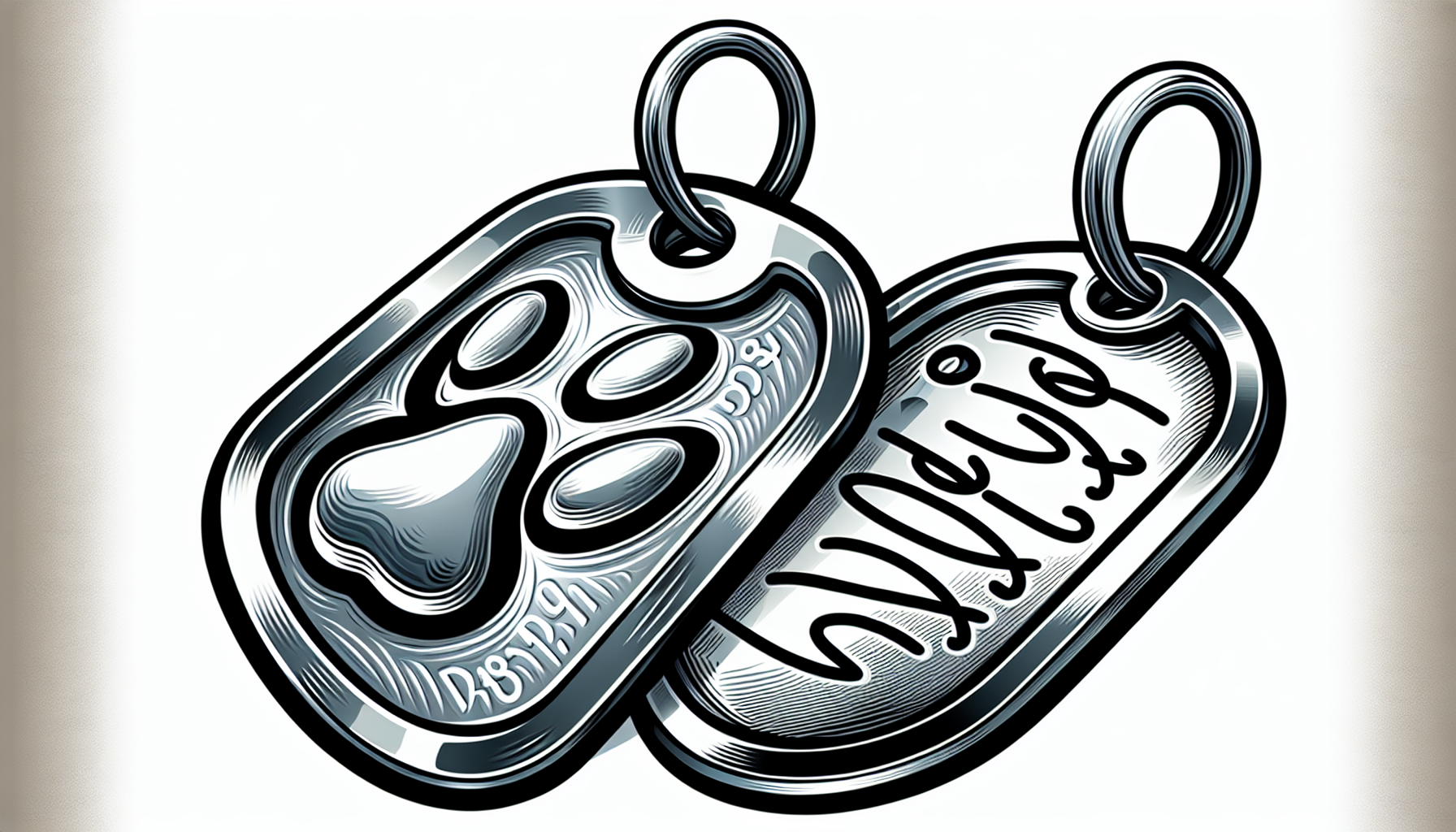What needs to be on a dog ID tag? Simply put, you should include your main contact information, a backup contact, and any urgent medical info. This guide explores these key details and additional tips for a more effective ID tag.
Key Takeaways
- Make sure your dog’s ID tag includes primary contact info, a secondary contact, and any crucial medical details to help ensure a quick and safe return if they go missing.
- Using both sides of the ID tag for information, offering a reward, and noting your dog’s unique behaviors can improve the chances of your pet being returned safely.
- Consider additional identification methods like microchipping, GPS trackers, and licensing with the local government for extra security and optimal pet identification.
Essential Information for Your Dog's ID Tag

A dog’s ID tag serves as more than just an accessory; it plays a crucial role in guaranteeing their safe return if they ever go missing. The right information on a dog’s tag can make all the difference between a quick reunion and a prolonged separation. The primary pieces of information you should include on a dog ID tag are your primary contact info, a secondary contact, and any important medical information.
Primary Contact Info
Your primary contact information is arguably the most important detail on your dog’s ID tag. This includes your name, phone number, and home address. Adding specific details like your cell phone number and street address, especially if you are traveling, ensures that anyone who finds your dog can quickly and easily get in touch with you.
For a quick reunion, make sure your contact info is clear and easy to read.
Secondary Contact
If you’re unreachable, listing a secondary contact on your dog’s ID tag could potentially save the day. This secondary contact could be a trusted friend or family member who can step in if needed.
Without a secondary contact, there might be unnecessary delays in reuniting with your pet if the primary contact is unavailable.
Medical Information
For your dog’s safety, it’s important to include any vital medical information on their ID tag. Short phrases like ‘Needs meds’ or ‘RX needed’ can alert anyone who finds your dog to the urgency of the situation. Additionally, noting any allergies or that your dog is microchipped can be life-saving details.
Additional Tips for Effective Dog Tags

For even more effective dog tags, you might want to consider these additional tips. Using both sides of the tag, offering a reward, and noting any personal quirks can significantly enhance the usefulness of your dog’s ID tag.
These minor tweaks could significantly increase the chances of your dog’s safe return.
Use Both Sides
Maximize the amount of information on your dog’s ID tag by using both sides. This allows you to include more details without sacrificing legibility. For example, you can put your primary contact info on one side and medical alerts or secondary contact details on the other.
Reward Offer
Including a reward offer on your dog’s ID tag can motivate people to return your lost pet. While this can be effective, be mindful that it might sometimes lead to unintended consequences, such as people chasing your dog to claim the reward, which could be dangerous.
Personal Quirks
Noting any unique behaviors or quirks on your dog’s ID tag can help dog owners handle your pet better. For example, if your dog is shy or has specific fears, mentioning these can reduce stress for your pet and assist the finder in managing them appropriately.
Phrases like ‘I’m friendly’ or ‘If I’m alone, I’m lost’ can be very helpful.
Choosing the Right Type of Dog Tag

Choosing the correct dog tag requires careful consideration of multiple factors, including:
- Material
- Shape
- Size
- Quality of the engraving
Different dogs have different needs, and choosing the right dog’s collar with a suitable d tag, like two dog tags, can ensure durability and readability over time.
Material Options
Dog tags come in various materials, each with its benefits and drawbacks:
- Stainless steel: highly durable, resists corrosion and scratches
- Anodized aluminum: offers durability, comes in various colors
- Titanium: high-end option, perfect for active dogs due to its rust and corrosion resistance
Plastic and aluminum hanging tags are lightweight but may wear out faster.
Shape and Size
Dog tags are available in many shapes and sizes, allowing for personalization. Popular shapes include bones, circles, and hearts. The shape and size should be chosen based on your dog’s comfort and the amount of information you need to include.
Engraving Quality
To ensure that the information on your dog’s ID tag stays readable over time, go for high-quality engraving. Laser engraving tends to be more durable than traditional methods.
Especially for active dogs who may subject their tags to a lot of wear and tear, it’s important to have clear and durable text.
Other Identification Methods

Dog tags may be the most common pet identification method, but other methods can offer extra security layers for pet owners. Microchipping, GPS trackers, and licensing with local government are excellent alternatives or complements to traditional pet id tags, dog id tags, pet tags, and a pet’s id tag.
Microchipping
Microchipping involves implanting a tiny chip under your dog’s skin that stores identifying information. This method is widely recommended because it provides a permanent form of identification.
Including a note on your dog’s tag that they are microchipped can alert finders to take them to a vet or shelter for scanning.
GPS Trackers
GPS trackers are a modern solution for keeping track of your dog’s location. These devices allow you to:
- Monitor your dog’s whereabouts via a smartphone app
- Be alerted if your dog leaves a designated safe zone
- Track your dog’s activity levels
- Set virtual fences to keep your dog within a certain area
Regular charging of the tracker is necessary to ensure it’s always ready for use.
Licensing with Local Government
Licensing your dog with the local government is important for proper identification and compliance with local regulations. It ensures that your dog’s vaccination and health records are up-to-date, which can be crucial in case of an emergency.
Maintaining and Updating Your Dog's ID Tag

For your dog’s ID tag to remain effective, it’s important to keep it maintained and updated regularly. This includes regular checks for wear and tear, updating information promptly, and using temporary tags when necessary.
Regular Checks
Inspect your dog’s ID tag at least once a month to ensure it remains legible and securely attached. Regular checks can prevent issues like fading or damage, which could render the tag ineffective.
Updating Information
Whenever there is a change in your contact information, such as a new phone number or address, update your dog’s ID tag promptly. This ensures that anyone who finds your dog can reach you quickly.
Temporary Tags
Temporary tags are useful while waiting for a new permanent tag. These can be handwritten with your current contact details and used to ensure your dog is always identifiable.
Special Considerations for Traveling with Dogs
When traveling with your dog, you need to take special care with their ID tag. Including travel-specific information, considering language differences, and adding emergency contacts can help ensure your dog’s safety during your travels.
Travel-Specific Information
When traveling, include both day and evening cell phone numbers on your dog’s ID tag to ensure you are reachable at all times. Adding an email address and the address of your travel destination can also be beneficial.
Language Considerations
If you’re traveling internationally, consider engraving your dog’s ID tag in the appropriate language for the destination. Using universal symbols like phone icons can also enhance communication.
Emergency Contacts
Include emergency contact details of someone at home and at your travel destination on your dog’s ID tag. This ensures there is always someone who can be reached in case of an emergency. Adding the contact information of a local veterinarian can also be very helpful.
Summary
In summary, a well-prepared dog ID tag is a small but mighty tool that can make a significant difference in ensuring your pet’s safety. By including primary and secondary contact information, medical details, and using both sides of the tag, you can maximize its effectiveness.
Remember, maintaining and updating your dog’s ID tag regularly, considering special needs during travel, and exploring additional identification methods like microchipping and GPS trackers are all part of keeping your furry friend safe. Equip your dog with the right ID tag, and you’ll be prepared for whatever comes your way.
Frequently Asked Questions
What should be included on a dog ID tag?
Make sure to include primary and secondary contact information, as well as any important medical details on your dog's ID tag. It's crucial for their safety and well-being.
How often should I check and update my dog's ID tag?
You should check and update your dog's ID tag once a month to ensure the contact information is current.
Can I use both sides of the dog tag?
Yes, using both sides of the dog tag maximizes the amount of information without compromising legibility.
What materials are best for dog tags?
Stainless steel is the most durable material for dog tags, but anodized aluminum and titanium are also good choices. Choose based on your needs and preferences.
Are GPS trackers a good alternative to dog tags?
Yes, GPS trackers are a good alternative to dog tags, but it's best to use them along with traditional ID tags for the best safety.
You Might Also Like...










